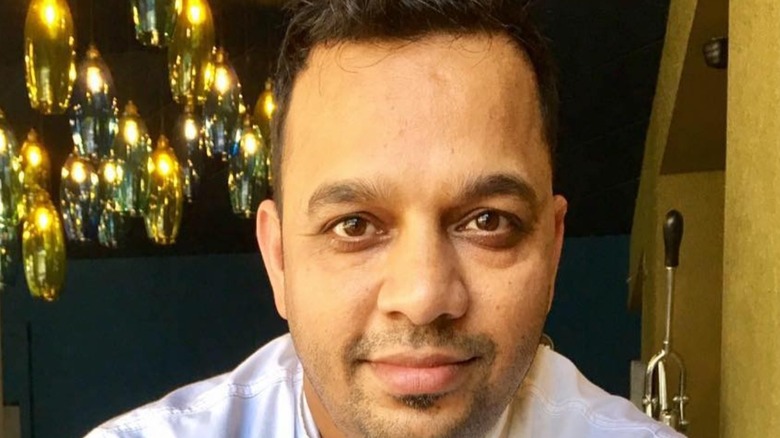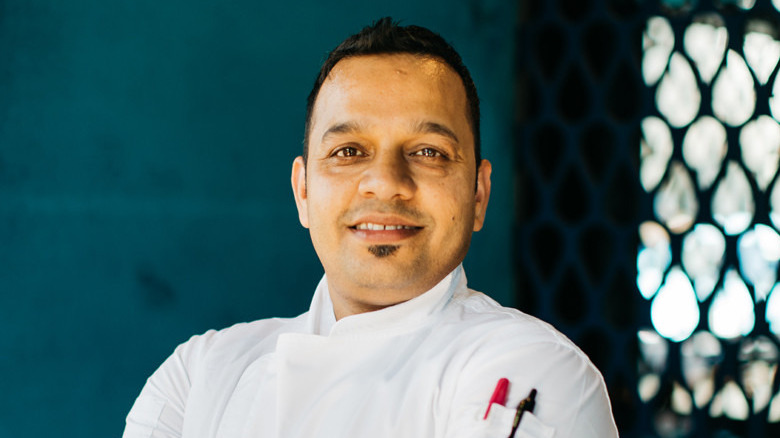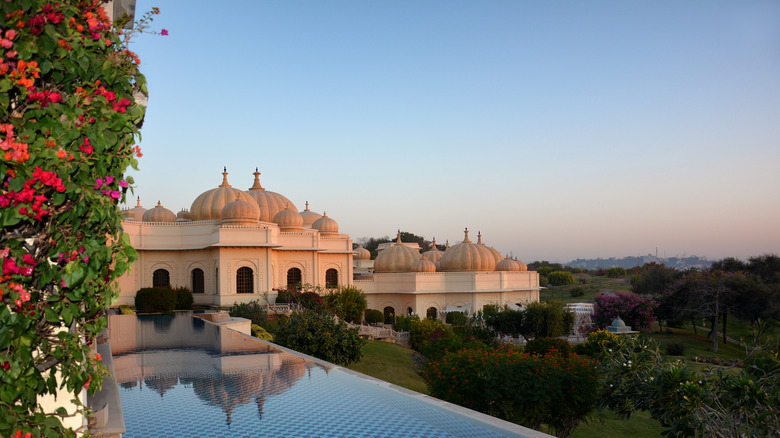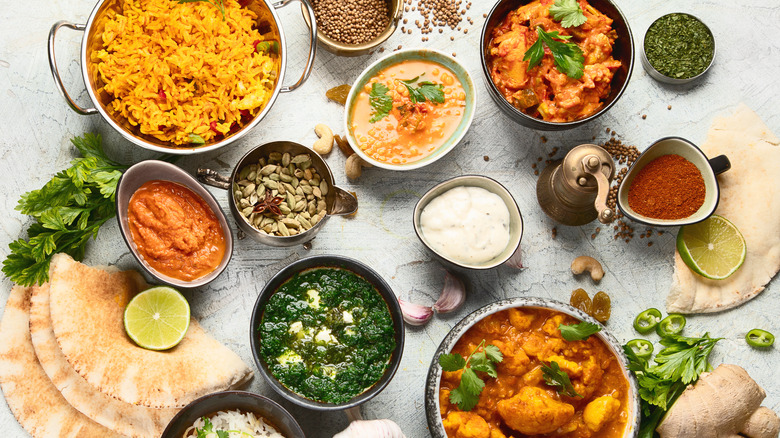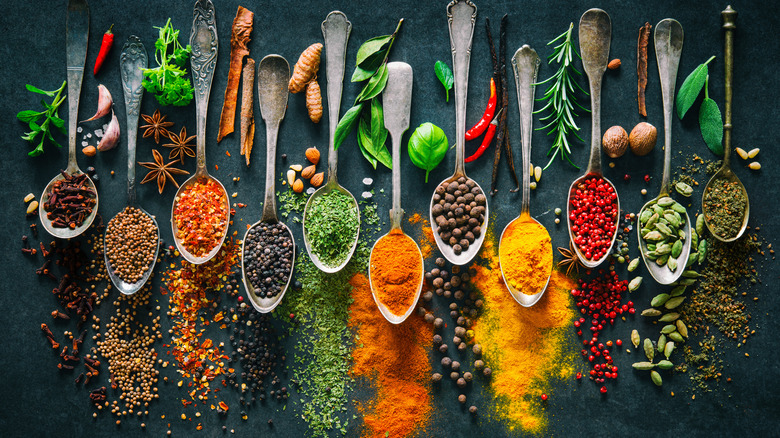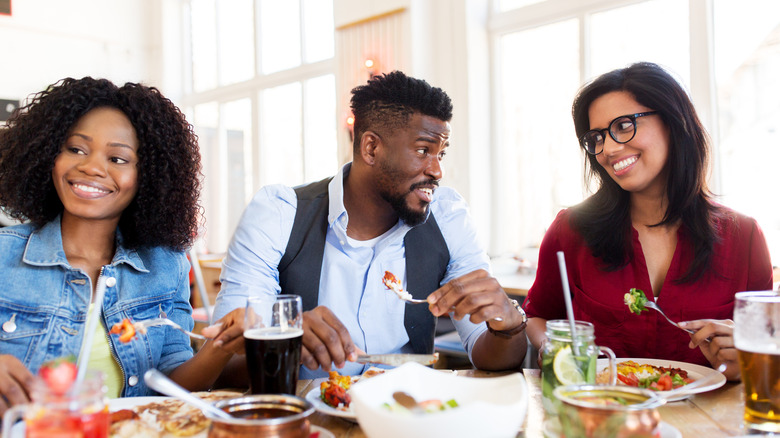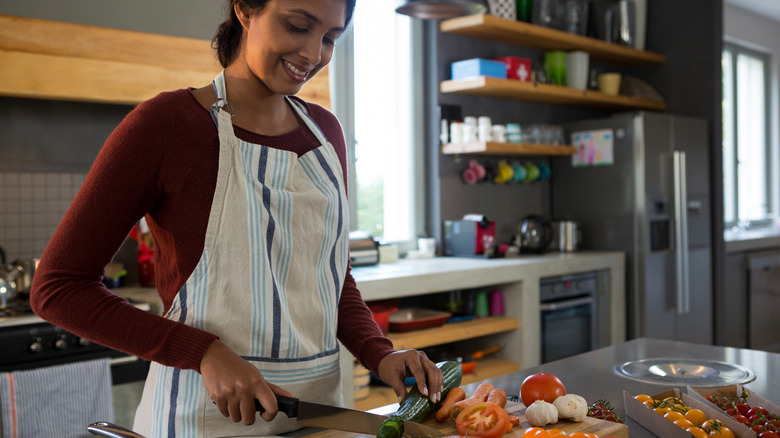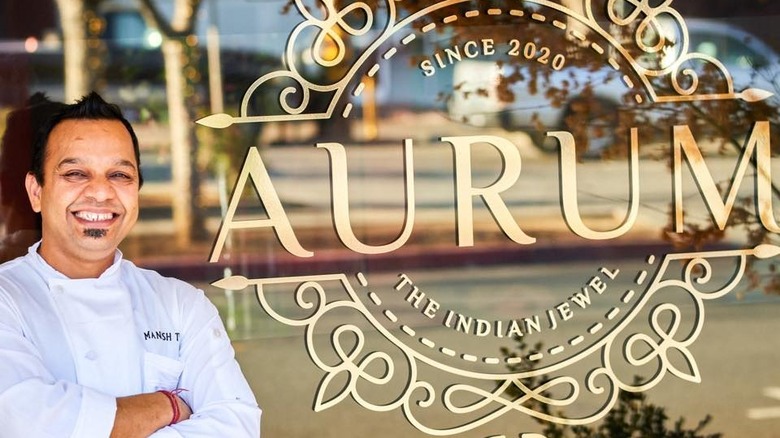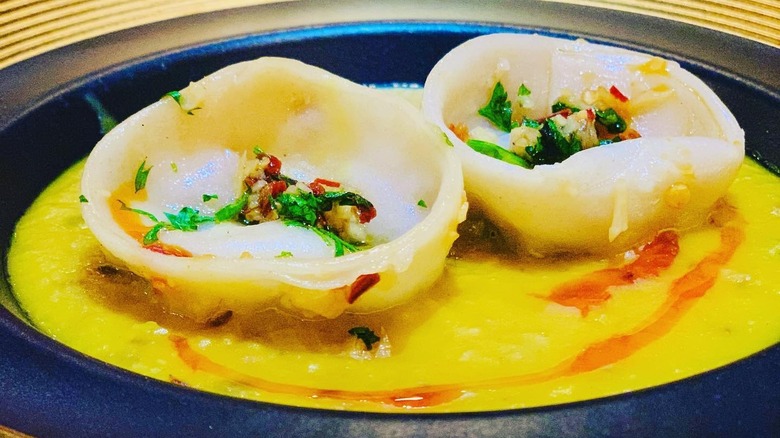Beat Bobby Flay Winner Manish Tyagi Tells Us All About Indian Food - Exclusive Interview
When Chef Manish Tyagi — the man behind the menu at celebrated Bay Area contemporary Indian restaurant Aurum – was growing up, few men sought to make cooking their life's work. At least that was the case in his native country of India. Despite his path being an unconventional one for the time and place, his life's journey was always headed toward the kitchen. After all, that's rather where his life story starts, too: watching his mother cook up wonderful foods for family, friends, and guests.
"Actually, my cooking started pretty early," the chef told Mashed during a recent interview. "The thing in India actually, during [the] '80s when I was growing up, it was still kind of a culture [that] was pretty much a nucleus family focus all over. Though my dad was in government services, so we were kind of away from home a lot, but the influence of that nucleus family actually was on my dad a lot. He was a guy [who] used to invite people all the time [to our] home, kind of feeding meals to them. Every now and then we used to have some guests at home and my mom [would] end up cooking last-minute stuff because she never used to get heads up from dad, like: 'ey, guests are coming to [our] home!'"
These impromptu dinner parties for which Chef Manish often helped his mother prepare food with very little notice would turn out to be good preparation for his later life in the kitchen. Though at the time, he was just trying to be a helpful son, not eyeing a life's calling. That came soon enough, though.
How Chef Manish Tyagi came to professional cooking
When did you know cooking was going to become a career and not just a hobby or something you did for fun?
So when we were growing up, it started with that helping my mom. And then I was good at cooking, I guess, naturally. We were two brothers, my brother and I, and we used to divide our jobs. My brother used to help in cleaning the utensils and other stuff and serving the guests. And I was kind of helping my mom as her assistant. I would have to finish something for her or check the salt in the sauce or any curry she's making just to give her confidence, to be studying the stuff while she's busy on other stuff. It started up like that.
By the age of 10 or 12, I was a pro in making chapati, which is the flatbread, which is even hard for Indians, especially for males because in India it's very, very, very gender-specific. Roles are very gender-specific, even during that time. Cooking is a lady's job. When it comes to home cooking, it is kind of [a] lady's job, [with] men just kind of trying to avoid it. And [a man] would never speak of cooking in a gathering; if they cook at home or something, other people used to go: "Hey, you are kind of scared from your wife? That's why you're cooking?" Kind of funny things like this.
[But] taking it as a career, actually, I never decided. As I said, when we are growing up in the '80s I [was cooking] at home, it was 1998 when I was doing my high school, and then I was in the second year of my college. I was pretty confused [about] what I'm going to do with my life. There were not many ... professional school options around me, so whatever jobs I was getting in front of me, I was just applying for them so that I just don't end up doing a plain BS degree in math and statistics. I was studying math and statistics at that time. I thought, "I have to do something as far as professional qualification is concerned so that I can get jobs easily."
The minimum qualification for a catering college during my time was high school. Already I was crossed two years. So this was in [the] back of my mind that I'm going backwards, but I didn't have [many] options available. I got selected in engineering, but college was very far, and the fee structure was out of our budget. So I dropped that idea and picked up this catering college thing. ... I was not sure even after completing my three years of this catering college diploma that [I would] go in the kitchen because I used to love cooking, but had no feeling that I can do it in an industrial way.
Manish Tyagi discusses his first professional jobs in the food industry
So what was your first professional experience in the culinary world?
I was more leaning towards F&B services and kind of honing my knowledge on wines and the spirits and breweries. In my campus interview, I cracked a couple of rounds. And then the final round was to happen in one of the premier hotel chains units ... Oberoi group of hotels. There are like three premium groups in India, actually, who have a quite big name, as far as the hospitality industry is concerned. One is Oberoi group of hotels ... [it] is one of the premium ones as far as young aspiring catering colleges students, because they're having a very good program for learning for any youngster who wants to join [the] industry. And most of the employees they're having all are young. Actually, they keep that kind of a standard that if you are getting older, either you rise in the career level or you tend to leave that organization and go somewhere else.
In [my] final interview, my interview was taken by the executive chef, as the F&B manager was on vacation, so he pulled me into his team because he was also looking for chefs. He kind of got biased. And rather than just taking a simple interview he thought, "Why don't I have this guy in my kitchen?" That's how I got into the kitchen. I guess mostly it was my destiny rather than I chose it as my career. I kind of started enjoying it initially. A couple of months were hard and I had so many hard times that I thought, "I should leave this, this not my cup of tea." The working hours are long, and then you get bullied a lot when you are new.
It's not only work pressure. It is how you preserve yourself in that environment, in that culture, and how you kind of stand to those challenges. That also makes a difference. In India, there is only a 3% success rate of any fresh catering college graduate who makes it a lifetime career. Otherwise, they leave it in middle ... like some do it two years, some do it five years ... and then they kind of choose some other profession because the lifestyle is tough. If you're not really enjoying it, then you're going to start burning out ... and you tend to leave it.
So my case, I started enjoying it, got mentors who influenced me a lot and kind of encouraged me to read more, learn more, and do all these experiments and cross my boundaries. That helped me in growing in my career very fast. Joining the industry in 2003, I become executive chef of a five-star hotel by 2007, and [was] taking care of four multiple units in 2008 of Taj group of hotels, having more than 100 plus five-star hotels in India. So kind of quite an achievement and [that] helped me in committing.
Chef Manish Tyagi dishes finding a balance between tradition and healthy in his cooking
How much of a role does traditional Indian cooking play in your approach versus adding new and original twists to dishes you make?
Any dish I make, the soul of that dish is traditional cooking or in a traditional style or based on traditional element. My idea is to represent them in a modern way, adding the necessity and value of today's requirements that we need. I don't want to make anything which looks fancy and is not very healthy — until or unless somebody wants to go for it and like it anyway. Like ice cream, it's not healthy, but we consume it now and then. So certain items which you cannot make in a healthier version of that, then I do certain compromises in that. Otherwise, my approach is to make food as healthy as possible so that our calorie intake is not high. My guests should not feel sluggish after a meal. They can be refreshed when they're having it.
Still, the base of my dishes is traditional. And then I add on modern techniques, my influences from other cuisines so that I can use their techniques in creating a similar product. And visual appeal is very important for me. I change techniques to create those visuals actually so that when you look [at the] dish, you feel that, wow, this is amazing.
The quintessential ingredients in Indian food, according to Manish Tyagi
Whether speaking traditionally or the way you cook today, what are a few of the most essential ingredients and spices in Indian food and in your own cooking?
There are personal favorites for all chefs, and in Indian cuisine, you must have heard a lot of times chefs say, "This is authentic!" Well, this is not authentic, this is [usually] their way of making it. Indian cuisine in my knowledge, is a cuisine where what you make [you do] it your way. Otherwise, there is no record of any authenticity. Indian culture is more than 1,000 years old now. It has the influence of a lot of other factors — a lot of invaders come to India, a lot of scholars come to India. They started living and working there.
A lot of communities come to India. They started living over there, like Persians. Persians kind of migrated to India when their country had been taken over by Iran. So they bring their own culture, their food, and mixed it with Indian food turning [it] into a totally new cuisine. Same thing as with the Portuguese. Portuguese come to another coastal area of India. Their food is totally different. It's not even Portuguese. It's not even Indian. It's Goan food now. It's kind of an amalgam of two different cuisines turned into a third cuisine.
Same thing is with the ingredients. Cinnamon is not native to India, but it is consumed more than in any other country in India now. Chilies, red chilies, these are more like Latin American stuff. We never used to have it before. The only spice, as far as to make thing hot, used to be peppers, black peppers, green peppers, which is kind of pure Indian stuff. Now we've been exposed. When all this came, some must have happened 1,000 years back, but a lot of action happened after that time. As for people's adaptation and people's liking, a lot of things changed.
That's what I'm doing even here. For me, essentially, ingredients are fenugreek leaves, ginger, very basic stuff ... garlic, green chilies. I try to flavor my food with these fresh herbs and vegetables rather than adding more of these complicated ... concoctions. I use certain blends of spices also, but mostly my approach is to keep my food simple, like you can feel what you are eating. You can kind of connect with it and understand what spice has been used in this.
What Americans get wrong about Indian food, according to Manish Tyagi
What are a few things that Americans misunderstand about Indian food? And are there any things you wish Americans knew more about the cuisine?
My approach is very straightforward in that [the] idea is to educate people, educate Americans, with the food that I'm serving at the restaurant, so that they can ask me why this kind of food [is what I'm] serving and why they are not getting the regular Indian food. What they call Indian food in [many] Indian restaurants, why they're not getting it in my restaurant. It's because actually, that is not the real representation of Indian food. Yes, that food is Indian, but that is food that originated in restaurants.
... I would say that food is more close to [the] U.K. than India. That is not homestyle cooking food. And it's actually similar in every cuisine, whether you call it Italian cuisine or whatever, you see? The way we perceive pesto here, pesto is not the way they make it [in Italian cooking]. Their pesto is more granular. Every region has their own style of making their pesto. Same way with a pizza, or if you go to Chinese cuisine, the way we get Chinese cuisine here, it's not the right representation of what Chinese food is in their country. It's [like this] with every cuisine.
My idea is to educate [people], tell them what the style is, and to [make it easy] to correlate with the things. The way I'm cooking ... okay, I have dish called mushroom pot pie. I just gave that name so that anybody who never had Indian food can actually picture it in their mind. When they enter an Indian restaurant, [they know] they're going to have something Indian, but at least this name is going to give them some sort of a way that they can visualize the food and feel comfortable ordering it. Otherwise, if I put a more traditional name, they are [not] going to have a clue what they are ordering. Or they're going to order completely based on somebody else who is going to suggest to them that this is a good [choice] for you. This is not good for you, so on.
Same thing with the arancini. Arancini, the reason for using that word is, again, it is kind of having some resemblance they can use while they are ordering it. Otherwise, I'm not using any bacon in that. I'm not using any chorizo in that, or any meat in that. The only common factor is the rice. Rice is there. They use risotto, I'm using my rice. Otherwise, it is based on my comfort food, khichdi — Indian comfort food. What we grew up eating when our mom used to feed us in the kitchen.
Chef Manish Tyagi's advice for home cooks interested in Indian food
What are a few pieces of advice for the amateur cook who wants to try to start making Indian food at home?
Use your own cooking skills and background in your cuisine when you're cooking Indian food. The only difference in Indian food and non-Indian food is [the] number of steps. Otherwise, you'll see the method of cooking is very similar. There are sautéing methods. There are stirring methods. There are frying methods. There are poaching or broiling methods, so really the methods are same. The only difference is the number of steps [that] kind of get added in Indian cuisine.
In other cuisines, mostly either you use fresh herbs or you use dry herbs. In Indian cuisine, we use fresh herbs as well as dry herbs in the same thing. And use of spices definitely. We make things complicated, you can say in other words. That creates the complexity, the overall flavor bomb, which can kind of [be] generated because of that amalgam of different spices and different herbs in each dish.
My advice is ... to experiment with it. And now actually there is a lot of literature available on YouTube and other platforms. They can go through it. They can take a look at two or three different variations of the same thing available on YouTube nowadays and judge for themselves, which is why [people] are finding foods closer to their likings and then trying it in their own fashion, rather than making things complicated. That's my advice actually.
Manish Tyagi on his restaurant Aurum
If a visitor was going to go to Aurum and could only try one dish, what would you say is the one they should try?
Oh man. I'm going to ask him how hungry he is. Maybe two or three dishes? Okay, definitely I'm going to give him a taste of my spiral chaat, Mr. Potato. I'm going to definitely start with Mr. Potato, the spiral chaat we have, which is unique. Or if he or she's not into dairy, then I'm going to offer them our cauliflower bezule, which is vegan. If he wants to have meat rather than vegetarian stuff, then I'm going to offer him pulled pork tacos. Here again, tacos I'm calling it. Otherwise, it is not a taco. It's having a very traditional bread from one region and preparation from another region. I'm serving it in a style of a taco. Otherwise, it's a whole wheat bread with fenugreek leaves and beet-reduced liquid.
In entrees, again, there are choices. If [the guest] is vegetarian, then I'm going to tell them to try my saag paneer lasagna. If they are a vegan, then I'm going to tell them to try my eggplant masala. If he says I'm okay with meats, then I'm going to tell him to try either sea bass or lamb chop.
How does the California culinary scene influence your cooking at Aurum?
Actually, now I guess I'm more Californian than Indian ... living here for the last nine years, kind of now it's in my blood. Having been exposed to so much good produce, every time I go around here, it kind of encourages me to push my boundaries and try new stuff. My cuisine is now more Indian-Californian kind of. We try to use all the fresh ingredients available and I change my menu every three months to introduce them.
Manish Tyagi talks about competing against Bobby Flay
How is cooking on camera different from your everyday experience, and what was it like cooking against Bobby Flay?
Oh, a lot, a lot different. Cooking on camera is more like you are in a boxing ring and you're just actually controlling your nerves. There is no time for creativity. Or okay, there is some time for creativity, but still you have to think everything must fit in that time frame. If it is creative, but won't fit in your timeframe, that is a waste of time. In front of a camera, you have to be quick in terms of what you want to do and very, very confident [about] what you're doing. If you are in two minds, you are going to lose.
When you having an opponent like Bobby Flay, who is a master of that timeframe because he's been doing, I guess, 27 seasons by now, you can't beat him by that timeframe. You will figure out a different approach or make things in a totally different way, the way I did for saag paneer, so that he completely gets shocked [about what it is] I am cooking Indian. [Those] were his words: "... I'm cooking Indian or what he's cooking Indian?"
What were some of the biggest surprises from the show and what was it like when it was over?
One surprise ... I've been using shrimp whole my career, but never felt the value of using the head of the shrimp, and the tail actually. That was a learning [experience] for me. Another learning was I never fight with time like that. We normally do that some, but [you] never had this sword hanging over your head. You have to finish it in this clocked time, otherwise, it's of no use.
In [the] kitchen also, when we are doing the operation, it is always, always a high moment of your anticipation that every table's food dish [gets] out on time, go to the guest. We have a 70% or 80% success rate in that, but still, even 20%, if you're five minutes late or seven minutes late, that is again okay, the guest is not saying, "I'm not going to eat this food now!" But at the show, if you're late, if you're not able to finish your dish, you're done.
What Chef Manish Tyagi loves to cook (and doesn't)
Beyond Indian cuisine, what is your favorite cuisine to cook and to eat?
I am a big fan of Chinese food as well. I like Chinese, Mexican, and Italian. Italian is more close to me because this is the first international cuisine I learned while I was learning this trade during the initial phase of my career, so this is very close to me. And a lot of my dishes actually speak about how close I am with this cuisine.
What dish do you never get tired of preparing?
Actually, I get tired of everything after a while. I'm a person that actually wants to do something new every time, but being in this industry you have to do certain adjustments and compromises because you have to meet the customers [expectations] as well. If you ask me, I don't want to cook this or that [again] now because I'm done with it. I want to do something new, but my guests want to eat it again and again. So I have to keep that in my menu.
There is one thing actually I'm really proud of making, but again, I try to do some variations in that. That is [a dish] with a kind of a honeycomb structure. It's a dessert in my menu. We call it ghevar. It's an art actually making that. Ninety-nine percent of people fail in their first or second try of making that. You need specific skills actually to make the batter because it is an emulsion of clarified butter, water, and flour. To make it into a balance and not curdle it is an art, and then pouring it from a certain height in oil in a three-inch ring mold at the temperature of 420 degrees Fahrenheit. It takes easily two minutes to three minutes to make one of that honeycomb structures. So I feel proud that I'm able to master that skill. That is one of my signature [dishes] that I'm carrying from the last six years now.
I made some certain variations in that, used matcha, other stuff. Again, matcha is not Indian, but I tried that. Then I had a dehydrated beet added to the batter so that I can see what changes it makes to the action of the pastry. That also turned out really well with a coffee flavor. I do changes in my dishes so that I don't feel bored ... so I have something new to offer.
If you're in the Los Altos, California area and want to try Manish Tyagi's unique honeycomb-style dessert for yourself, be sure and drop by his restaurant Aurum.
